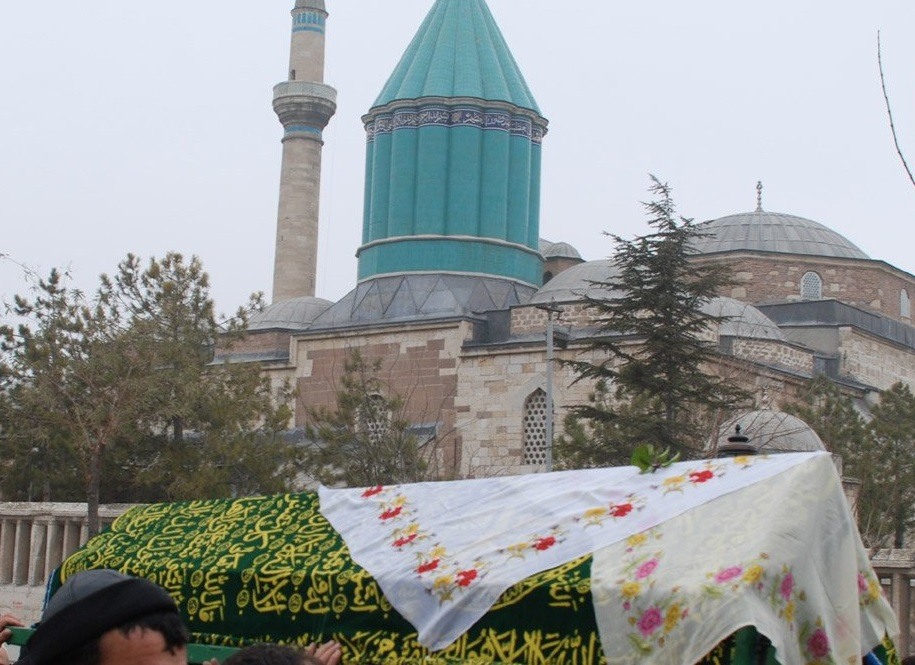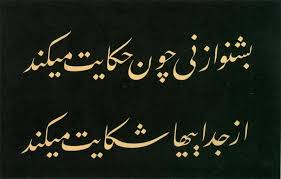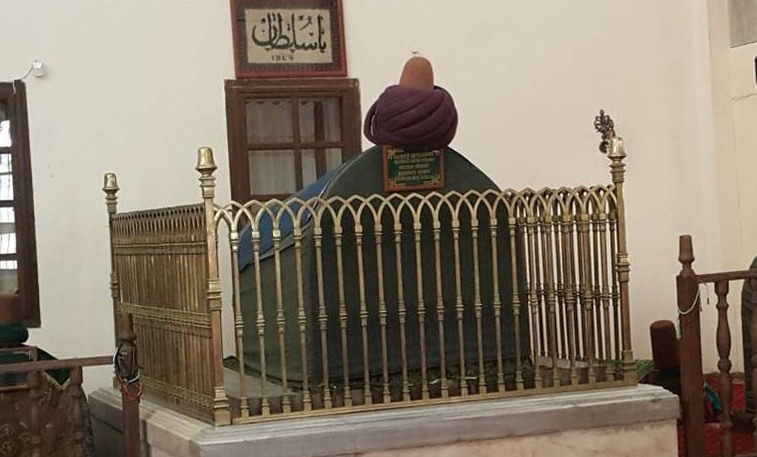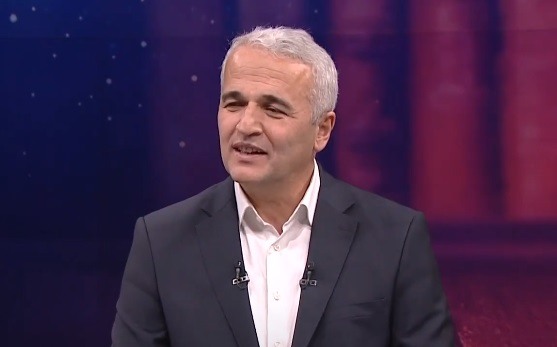An Introduction of the MS Available at the Mevlana Museum, Konya, Turkey. – Erkan Türkmen
An Introduction of the MS Available at the Mevlana Museum, Konya, Turkey.
Erkan Türkmen
In my article (Maulana Ahmad Husain Kanpuri and Indian Commentries on Rumi”s Masnevi published in the Islam and Modern Age,
Journal No.XXXV, February 2005, New Delhi) I had drawn attention of scholars to Masnevi”s most authentic MS available at the Mevlana Museum Konya, Turkey (reg. No.50). A facsimile of the same has been made available in three different sizes by the Ministry of Cultural Affairs, Turkey, 1993 (ISBN No. 975171452-4). I shall like to throw further light upon the MS as it can be authentic source for the scholars.
When Masnevi traveled from Konya (Central Anatolia) to Iran, Afghanistan and India, many changes were made in the verses of the work by scholars and scribers, which have to be taken into consideration before undertaking any further research on Rum”s Mesnevi. These changes can be divided into three groups: 1- Usage of defective MSS 2- Misunderstanding of mystic meanings of some terminology and symbols. 3- Changes introduced under the impact of the local traditions and beliefs of the country.
1- Usage of defective MSS:
The earliest good scholars who began to search for an accurate MS were Abdulbaki Gölpınarlı from Turkey (1), Nicholson from England (2) and Feruzanfer (3) from Iran. Nicholson, most probably due to the Second World War, could not visit Turkey to see any MS available in the Turkish libraries personally. Luckily, the MSS he received by post were not very different from the MS of the Masnevi of Museum, yet not perfect. Abdulbaki studied Museum copy, but made no critical edition or clarified the variants in details, although he made full use of the MS while making his translation into Turkish.
Nicholson did not go into essential references of the Koranic verses and relative Hadis relating to the Islamic Sufism (Tasawwuf) that form the fundamental frame of Rumi”s Masnevi.
MS of Mevlana Museum has 325 folioes, each 49 x 32 cm. Rough English of the colophon is:
“The illumination of it (the MS) has been made by humble Abdullah al-Hindi”
(The above lines are in the rubric)
“This book of Masnevi which is a guidance to the path; thanks to God and peace be upon Prophet Muhammad, has been completed by the hands of humble slave (of God), and who needs His mercy Muhammad bin Abdullah al- Konavi and disciple of (Sultan) Weled(Rumi”s son). This manuscript has been copied from the original MS that had been corrected by the sheikh and the author (Mevlana Jelal al-Din Rumi) and his khalife (Husam al- Din Chelebi) during some meetings. May God continue to disclose his (Rumi”s) secrets on the Muslims!
Completed in the sacred month of Rajab 670 (October 1278) when God has more mercy on the readers who look at it (the MS) and they may pray for the scriber”.
The very first verse of the MS reads as:
بشنو اين نى ﭼو ن شكا يت مى كند از جد ا ئها حكايت مى كند
And it is quoted by Eflaki Dede (author of the Manaqib al Arafin)(4)a decade after the death of Rumi, exactly the same way. It was changed later as:
بشنو از نى ﭼو ن حكا يت مى كند از جدائها شكايت مى كند
Accurate translation will be “Listen to this Nay (Rumi himself) while it is complaining and telling the story of separation (from its Origin = God). Here “The story of separation” is better than just “complaining”. In the second line we see “der nefirem” and not, “az nefirem”. Here again “der nefirim” suits the first line “een nay”, and is more emphatic as it means “in the presence of the nay (Rumi himself)”. As a matter of fact, the Nay of the eighteen verses is Rumi”s own spiritual state which was misunderstood by the fanatic groups in Konya. His Masnevi, being a non dimensional interpretation of the Koran, was hard to comprehend by the common people (awam). This is why some fanatic group tried to kill his spiritual master Shams, whose teachings and interpretation of the Koran were alien to them. Sufi”s Sema (transcendental dance) accompanied with music was shamanistic performance, and for them it did not seem to fit the Islamic tradition. Many fanatic Muslim scholars tried to deny such mystic elements and they changed the actual terms or interpretation of the Masnevi which they also do with the interpretation and translation of the Koran.
There is another old manuscript available at the Yusuf Agha Library, Konya (Reg.No.5547). This MS was previously dedicated to the Shrine of Rumi”s mother (Madder-i Mevlana Musuem) at Karaman. It has variants in the margin that belong to Husameddin Chelebi (shortened as “Husam”) and to Sultan Weled (shortened as “Weled”). This is, therefore, the first critical edition of the Masnevi. It also throws light on the Sufi terms used in Masnevi with the meanings as understood those days. For example the fourth line is:
هر كسى كو دور ما ند از اصل خويش باز جويد روزﮔار وصل خو يش
(He who falls away from his origin, seeks for an opportunity to join it again)
To explain the right meaning of the word “Origin”, “Hubul al watan min al iman = Love of country is a part of belief (Words of Prophet Muhammed)” has been given in the margin, which refers to the original land (vicinity) of God (i.e. the reed land), where man was once fresh and ever green like the reed of the flute by being watered with divine love and light. Now, separation from that land has made man (the flute) lonely and deserted. The spirit (breath of God) yearns for the Blower as the Koran says, “…I breathed into man my breath” (the Koran XV/28, 29). This breath (trust) man carries within him (Koran 33/ 72); and when he discovers the breath (trust of God) in him, he begins to look for God and feels like fish out of water. But he whose holes are blocked, like the imperforated reed of the Nay with worldly desires and strong ego, does not feel the breath of God in him; and thus has no feelings of separation.
The Yusuf Agha MS supports the above explanation by giving meanings of the terms Mahi (fish) and Nistan (the reed land) in the margin as: “juz mahi = ashiq nist” (not in love) and “hubul watan=love of country”.
Again, we learn through the Yusuf Agha MS that the Hadis of Muhammad, “Believers (Muslims) are each other”s mirrors” has been referred to by Husam as:
پيش ﭼشمت د اشتى شيشه كبود ز آ ن سبب عالم كبو د ت مى نمود
(You have placed blue piece of glass in front of your eyes, and because of that you see the world blue).
But Weled gives the verse as:
جام روزن سا ختى شيشه كبود نور خور شيد كبو دت مى نمود
(You have placed blue glass on your window; therefore, the light of the sun looks blue to you).
Both sound proper but Husam”s suggestion seems to be more logical.
Here is another example: The verse found in the story of “A Parrot and the Grocer” is as follows:
مى نمود آن مرغ را هر ﮔون شكفت تا كه باشد كاندر آيد او بکفت
(He showed all sorts of strange objects to the bird, so that he may begin to speak). (Nicholson Edition).
While the MM gives “Her gun shegoft”(all sorts of strange objects) and in the margin “Sad gun nehoft(hundreds of hidden objects) but Y.A. has only “Sad gun shegoft= hundreds of strange objects …” which sounds more suitable.
In some cases, Nicholson Edition (MI/1247) differs a lot:
ﭼو ن ملك انوار حق در وى بيافت در سجود و در خدمت شتا فت
When the angel found God”s light in him (Adam), he prostrated himself before him and hurried to be in his service.
The Yusuf Agha has:
ﭼون ملائك نور حق ديدند ز او جمله افتا دند و در سجده برو
When the angels found God”s light in him, they all fell down and prostrated themselves before him, face down.
I think the second form sounds better, because it suits the statement of the Koran.
Sometime we come across verses missing in Nicholson”s edition. For instance, there are four verses missing after the verse No. II / 3325 and one of them, being interesting, has been given below:
حوض با دريا ا ﮔرپهلو زند خو يش را از بيخ هستى بر كند
If a water pool begins to struggle with a sea, it uproots its own being.
In the above line by the sea God”s lover (Awliya = a saint) or God Himself is meant.
2- Commentaries that fail to grasp the mystic depth of the terminology of the Masnevi:
Examples above show that Masnevi cannot be understood without grasping the mystic terminology of the Koran. At first glance, many terms used by Rumi may seem to suit Hinduism, Buddhism, Greek Philosophy and others but they all agree with the mystic dimension of the Koran and tasawwuf (Islamic mysticism) “Nay” or Bansari may remind us of Lord Krishna”s magical charm, but according to Rumi it is human body with breath of God in it.
Masnevi is truly an indirect interpretation of the Koran as said by Molla Abdurraham Jami, although Mr. Nicholson does not seem to agree with him.
To grasp the real meaning of the Koran or Masnevi we have to pass from the akl-i juz (individual wisdom) to the akl-i kul (universal wisdom) and thence to the divine wisdom (“the ocean of divine wisdom” as named by Rumi). When we reach the divine wisdom, which is pure and above all negative feelings, we begin to love every creature, and religions fall behind as Rumi says:
ملت عشق از همه ملت جدا ست عاشقانرا ملت و مذ هب خدا ست
Nation of love is different from all other nations; their religion and belief is only God.
Some Indian commentaries try to show Rumi as fatalist (5). This is against the teachings of the Koran. It is said in the Koran, “Wa ina leysalil insana illa mas”a= Man is man to the extent he struggles and labours” which is certainly better than: “Cogito ergo sum= I am thinking, so I am”. So, the addition of the verse in the Indian MS as “Fikre ma der kar-e ma azare mast= Pondering over our deeds is only a self torture” is against the Koranic teaching and, therefore, against Rumi”s philosophy. Rumi says this in contradiction to the above verse:
ﮔر توكل مى كنى در كار كن كسب كن پس تكيه بر جبار كن
خواجه ﭼون بيلى بدست بنده داد بى زبان معلوم شد او را مراد
(M I / 947-948)
If you trust in God, then work hard; keep on working and put your faith in Jabbar(the over powering Lord); if a master puts a spade in your hands, without any words, his purpose is clear (here spade means two hands given by God).
Such additions and changes seem to begin to appear after Ibrahim Gulsheni (16th century scholar) in the Iranian and Indian MSS. Some scholars raised the number of the first eighteen verses to 22. Others transferred some verses from the sixth volume, and some even invented them. For example:
آنﭼه مى ﮔويد اندر اين دو باب ﮔر بﮔويم من جهان ﮔردد خراب
If I say what this (the flute) is saying about the two worlds; this world will be devastated.
سر نهانست اندر زير و بم فاش ﮔر ﮔو يم جهان بر هم ز نم
Secret is hidden in the highness and lowness of the sound; if I disclose it, I may devastate the world (6). Naturally, if new words and verses are added to the Masnevi, the commentaries will also be misleading.
3- Some commentaries indulge into superfluous details that make them insipid and boring. As shown above, they also depart from the Koran and Hadis that are the main sources of the Masnevi and plunge into Greek and Hindu philosophies. Such commentators could look up at the Koran first and then bring in examples from other religious books or philosophies.
As a result, it will be proper and safe to use the facsimile of Mevlana Museum MS, and for mystic terms and explanations Ysusf Agha unless the orginal hand written papers Qirtas by Husameddin Chelebi are found.
Note: Another remarkable point about the Mevlana Museum MS is that it had been illuminated by an Indian artist Abdullah al-Hindi. We do not know any thing about the gentlemen”s life. However, it can be guessed that there some Indian scholars and disciples of Rumi in Konya, who might had come from Afghanistan with Rumi”s father. There are stories about elephants, tigers, parrots and other Indian elements in Rumi”s Masnevi.
The drawings and illuminations have purely Indian taste. There is a Jin Jan motif drawn in the centre of the flower.
Prof. Dr. Erkan Türkmen
Near East University
Faculty of Arts and Sciences
Turkish Republic of North Cyprus.
References:
- Abdülbaki Gölpınarlı, Mesnevi Tercümesi ve Şerhi, İnkilap Aka Kitabevi İstanbul, 1981.
- R.A. Nicholson, The Mathnevi of Jellalu”ddin Rumi, Luzac and Co., London.
- Bedi”uzaman Feruzanfer, Sherh-i Masnevi-yi Sherif, Tehran 1373 and Kerim Zamani, Sherh-i Jami Mesneviyi Manavi, Istisharat-i Itla”at, Tehran 1374.
- Ahmet Eflaki, Tahsin Yazıcı, Manak al-Arifin, Türk Tarih Kurumu, Ankara, 1959.
- For details see Erkan Türkmen, Maulana Ahmad Huseain Kanpuri and Indian Commentaries on Rumi”s Masnevi, Islam and Modern Age, Vol. XXXV February 2005 and The Essence of Rumi”s Masnevi, Ministry of Culture, Ankara Turkey.
- Movlana Nazir Sahib, Muftah al- Ulum,Sheykh Ghulam Ali and Sons, Lahore
——————————————————————
Drawings:
- Carpet Design or rug for prayers (Jaynamaz)
Attached side flowers of the carpet.
- Side flower with Jin Jan referring to Rum”s philosophy that everything by its opposite.
- The divine eye with eye lashes (divine manifestation)
- The very first page of the Masnevi with the eighteen verses.
- The colophon of the MS
- Verses added by Sultan Weled shortly called Waledi (Rumi”s son).











